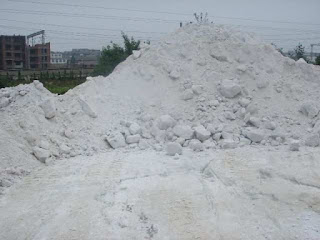Jaw crusher and its circuit
Jaw crusher is a kind of common mining machine.in a beneficiation plant, the first stage of size reduction of hard and large lumps
of run-of-mine (ROM) ore is to crush and reduce their size. Softer ores, like
placer deposits of tin, gold, mineral sands etc. do not require such treatment.
Large scale crushing operations are generally performed by mechanically
operated equipment like jaw crushers, gyratory crusher and roll crushers.
For very large ore pieces that are too big for receiving
hoppers of mechanically driven crushers, percussion rock breakers or similar
tools are used to break them down to size.
The mechanism of crushing is either by applying
impact force, pressure or a combination of both. The jaw crusher is primarily
an compression crusher while the others operate primarily by the application of
impact
jaw crusher structure
Jaw crushers are designed to impart an impact on a
rock particle placed between a fixed and a moving plate (jaw). The faces of the
plates are made of hardened steel. Both plates could be flat or the fixed plate
flat and the moving plate convex. The surfaces of both plates could be plain or
corrugated. The moving plate applies the force of impact on the particles held
against the stationary plate. Both plates are bolted on to a heavy block.
Fig. 1 shows a sketch of a double toggles and
controlled by a pitman. These are commonly used as primary crushers in the
mineral industry . The size of the feed opening is referred to as the gape. The opening at the discharge
end of the jaws is referred to as the set.
Fig1.
Double-toggle jaw crusher
Jaw
crusher circuit
Primary jaw crushers typically operate in open
circuit under dry conditions. Depending on the size reduction required, the
primary jaw crushers are followed by secondary and tertiary crushing. The last
crusher in the line of operation operates in closed circuit. That is, the crushed
product is screened and the oversize returned to the crusher for further size
reduction while the undersize is accepted as the product.
Jaw crushers are installed underground in mines as
well as on the surface. When used underground, jaw crushers are commonly used
in open circuit. This is followed by further size reduction in crushers located
on the surface. Open circuit flow sheets showing in fig2.
Fig 2. jaw crusher open circuit
underground, jaw crushers are commonly used in open
circuit. This is followed by further size reduction in crushers located on the
surface.
When the run of mine product is conveyed directly
from the mine to the crusher, the feed to the primary crusher passes under a
magnet to remove tramp steel collected during the mining operation. A grizzly
screen is placed between the magnet and the receiving hopper of the crusher to
scalp (remove) boulders larger than the size of the gape. Some mines deliver product
direct to storage bins or stockpiles, which then feed the crushers mechanically
by apron feeders, Ross feeders or similar devices to regulate the feed rate to
the crusher.
Alternately haulage trucks, front-end loaders,
bottom discharge railroad cars or tipping wagons are used. In such cases, the
feed rate to the crusher is intermittent which is a situation generally
avoided. In such cases of intermittent feed, storage areas are installed and
the feed
rate regulated by bulldozers, front loaders or bin
or stockpile hoppers and feeders. It is necessary that the feed to jaw crushers
be carefully designed to balance with the throughput rate of the crusher. When
the feed rate is regulated to keep the receiving hopper of the crusher full at
all times so that the volume rate of rock entering any point in the crusher is
greater than the rate of rock leaving, it is referred to as choke feeding.
During choke feeding the crushing
action takes place between the jaw plates and
particles as well as by inter-particle compression. Choke feeding necessarily
produces more fines and requires careful feed control. For mineral liberation,
choked feeding is desirable.
When installed above ground, the object of the
crushing circuit is to crush the ore to achieve the required size for down
stream use. In some industries, for example,
gold ore ,iron ore or coal, where a specific product size is required (iron
ore -30+6 mm), careful choice of jaw settings and screen sizes are required to
produce the minimum amount of fines (i.e. - 6 mm) and maximum the amount of
lump ore within the specified size range. For hard mineral bearing rocks like
gold or nickel ores where liberation of minerals from the host rock is the main
objective, further stages of size reduction are required. closed circuit flow
sheets showing in fig3.
Fig3. closed circuit




评论
发表评论